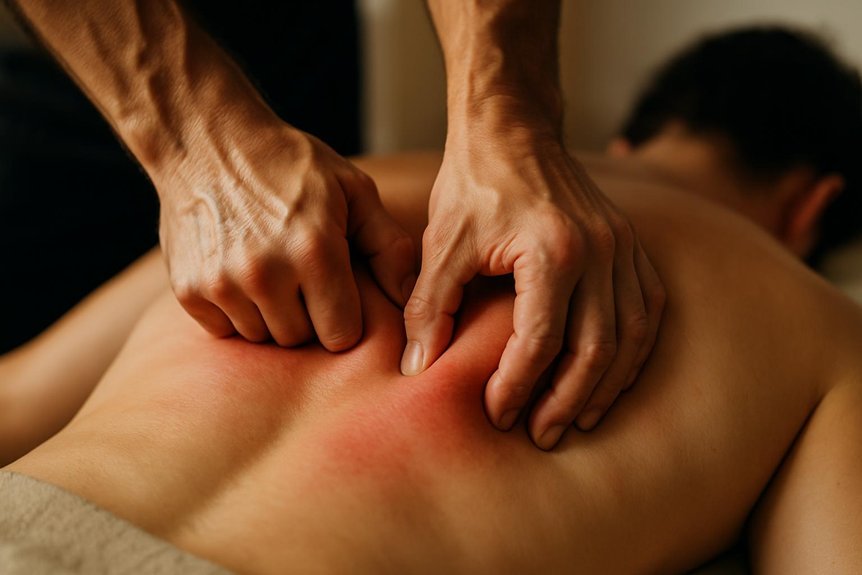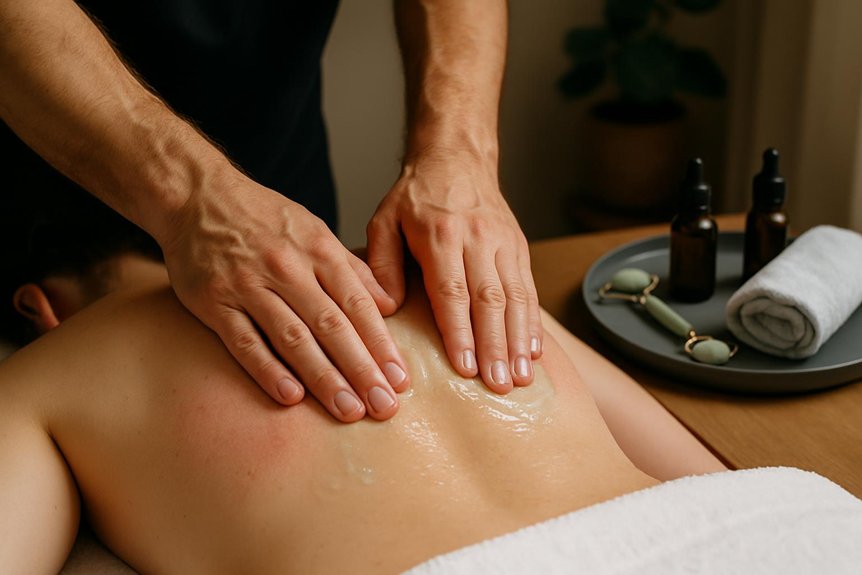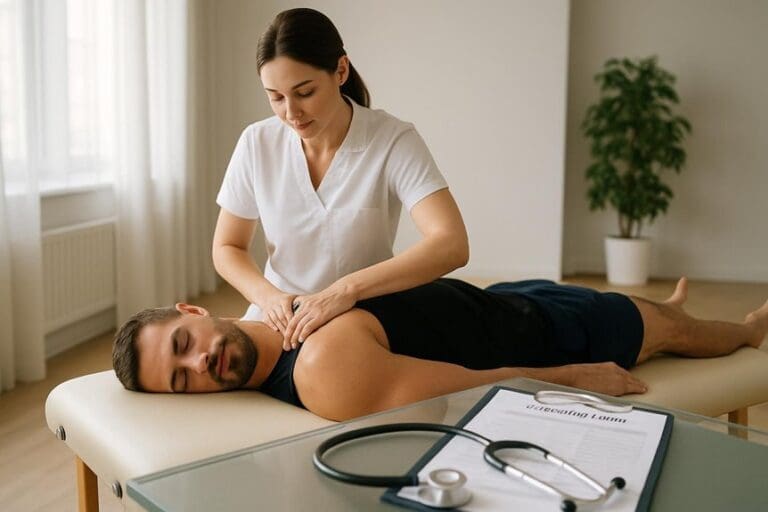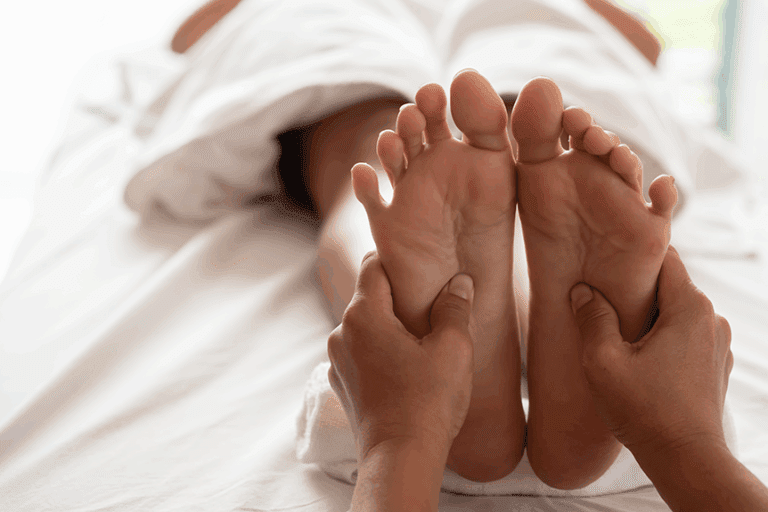It can trigger a brief, regulated inflammatory response that aids repair. Mild soreness peaking within 24 hours, without swelling, heat, bruising, or loss of function, is typical. Excessive pressure, rapid techniques, or pre-existing sensitivities (tendons, trigger points, vascular or oedematous conditions) may provoke disproportionate inflammation. Ethical practice includes informed consent, gradual pressure, monitoring tissue response, and tailored aftercare (hydration, gentle movement, cold compresses). Red flags include sharp pain, persistent swelling, numbness, or symptoms beyond three days. Further guidance clarifies risks, precautions, and recovery steps.
What Inflammation Means in the Context of Deep Tissue Massage

Why does deep tissue work sometimes leave tissues feeling warm or tender? Inflammation, in this context, refers to a short-lived, regulated immune response that facilitates repair.
Deep, slow pressure increases local circulation, alters fluid dynamics in fascia and muscle, and triggers mechanotransduction—cellular signaling that can upregulate healing processes. Mild heat, tenderness, or a “worked” sensation reflects vasodilation, transient microtrauma, and the body’s orchestration of recovery.
At Spa & Massage clinics in London, therapists tailor pressure to tissue response, monitor breath and tone, and avoid provoking excessive reactivity. They use fragrance-free or hypoallergenic oils, apply gradual depth, and pace techniques to respect client comfort and consent.
Post-session, therapists recommend hydration, gentle movement, and optional cool or contrast applications to modulate inflammatory mediators while preserving beneficial circulatory effects. Just as with the targeted pressure techniques in reflexology therapy, the aim is to encourage healing without overwhelming the body’s natural response systems.
When Soreness Is Normal—and When It’s Not
Although post-session soreness can be a normal, time-limited response to deep tissue work, patterns of intensity, duration, and associated symptoms determine clinical relevance. Mild, diffuse ache peaking within 24 hours and easing by 48–72 hours, without swelling, warmth, or functional loss, is typically expected.
Discomfort that remains proportional to pressure used and improves with gentle movement, hydration, and sleep is also reassuring.
Red flags include sharp or escalating pain, focal swelling or heat, visible bruising beyond small specks, numbness or tingling, night pain disrupting rest, or pain persisting beyond three days.
At Spa & Massage, therapists calibrate depth, gain informed consent, and invite feedback to prevent over-treatment. Clients are encouraged to report concerns promptly; urgent symptoms warrant medical assessment.
Common Triggers of Post-Massage Inflammation
Post-massage inflammation commonly arises from pressure-sensitive tissues—such as trigger points, tendons, and fascia—reacting to mechanical load beyond their current tolerance. Fluid shifts induced by deep strokes can transiently increase local circulation and lymphatic movement, mobilising metabolic by-products that may irritate nociceptors in susceptible individuals.
At Spa & Massage, therapists modulate pressure and pacing, screen for contraindications, and advise hydration and gentle movement to support ethical, evidence-informed care and reduce unnecessary inflammatory responses.
Pressure-Sensitive Tissues
Certain tissues are inherently more pressure-sensitive and prone to transient inflammation when subjected to firm manual therapy.
Myofascial trigger points, periosteum over bony prominences (e.g., ribs, shins), and musculotendinous junctions can react with short-lived soreness, warmth, or mild swelling. Superficial nerves and vascularly rich areas—such as the cervical plexus region, medial upper arm, or inner thigh—also warrant conservative pressure.
Recent injuries, post-surgical scars, and areas of heightened central sensitisation require additional caution.
In Spa & Massage clinics across London, therapists modulate depth, angle, and tempo, using graded exposure and client-guided feedback to remain within a tolerable pressure window.
They avoid sustained compression on vulnerable sites, employ slower melting strokes around joints, and reassess tissue response frequently—prioritising informed consent, comfort, and the smallest effective dose to support recovery without provoking unnecessary inflammation.
Toxin and Fluid Shifts
Beyond pressure sensitivity, inflammatory responses can also arise from shifts in interstitial fluid, lymphatic flow, and metabolic by-products mobilised during deep tissue work. Evidence suggests enhanced circulation can transiently elevate inflammatory mediators, especially where tissue has pre-existing micro-irritation. Fluid redistribution may also unmask latent stiffness, perceived as heaviness or warmth.
At Spa & Massage, therapists pace techniques to support lymphatic return while avoiding excessive shear. In sessions, oil choice and glide are calibrated to reduce frictional load, and clients are encouraged to breathe steadily to facilitate venous and lymph flow.
Post-session, our therapists recommend gentle walking, 1–2 glasses of water over several hours, and light mobility rather than aggressive stretching. Those with oedema, vascular conditions, or active infection are screened carefully, and pressure is modified or deferred in line with clinical prudence and client comfort.
How Our Therapists Minimise Inflammation During Treatment

At Spa & Massage, therapists minimise inflammatory risk through a structured approach that begins with a thorough pre-session assessment of medical history, pain patterns, and tissue reactivity.
Pressure is applied gently and progressively, adjusting depth based on client feedback and tissue response to avoid excessive mechanical load.
Targeted aftercare guidance follows—typically hydration, graded mobility, cold application when indicated, and clear red‑flag advice—to support recovery and ethical, safe practice.
Thorough Pre-Session Assessment
While each client presents unique risks for tissue irritation, a structured pre-session assessment allows Spa & Massage therapists to identify and mitigate inflammation triggers before any deep tissue work begins.
Clinicians review medical history, current medications (including anticoagulants, corticosteroids, and NSAIDs), recent injuries, surgeries, and known inflammatory conditions. They screen for red flags—fever, acute swelling, unexplained pain, neuropathies—and map symptom onset, aggravating factors, and sleep quality.
Objective checks include palpation for heat, edema, guarding, and tissue tone asymmetries. Clients’ goals are clarified, with informed consent documented and expectations aligned to evidence-based outcomes.
Therapists also note stress load and recovery capacity, guiding session scope and aftercare. In our London clinics, hypoallergenic oils are selected based on skin reactivity, and local contraindications are respected to protect comfort and healing.
Gentle, Progressive Pressure
A gentle, progressive pressure strategy is applied to modulate nociception and minimise post-treatment inflammation. At Spa & Massage, therapists layer pressure slowly, allowing cutaneous and fascial tissues to adapt before engaging deeper structures.
This graded exposure respects pain science: slower ramp-up reduces sympathetic arousal, limits microtrauma, and maintains local perfusion. Clinicians monitor breath, tone, and tissue compliance, adjusting depth when muscle guarding eases.
Ethically, consent is continuous. Clients are invited to use a 0–10 comfort scale; work stays within a “therapeutic tenderness” range, avoiding sharp or breath-holding pain.
Friction is moderated with hypoallergenic oils used in our clinics to reduce shear. Strokes are shorter over sensitive areas, longer over tolerant bands.
Sessions prioritise tempo, not force, to achieve change while safeguarding recovery.
Targeted Aftercare Guidance
How do precise post-session recommendations translate into less flare and faster recovery? At Spa & Massage, therapists provide targeted aftercare grounded in physiology and consent-led practice. Clients are advised to hydrate to support microvascular perfusion, use gentle active range-of-motion within pain-free limits, and apply 10–15 minutes of cool compresses to areas of heightened reactivity.
Where appropriate, therapists suggest alternating contrast showers to modulate circulation without provoking rebound inflammation.
They recommend protein-rich meals and magnesium-containing foods to aid tissue repair, while cautioning against vigorous exercise, alcohol, and heat exposure for 24 hours.
For local tenderness, they advise topical arnica or unscented carrier oils used in our clinics, patch-tested for sensitivity. Follow-up is scheduled within 48–72 hours to reassess symptoms, adapt intensity, and ensure ethical, client-centred progression.
Aftercare Steps to Reduce Swelling and Speed Recovery
Following a deep tissue session, targeted aftercare can limit post-treatment inflammation and support tissue recovery. Evidence supports simple, consistent measures: gentle movement within pain-free range, hydration, and sleep.
At Spa & Massage, therapists advise alternating brief cold applications (10 minutes on, 20 off) during the first 24 hours to modulate swelling, then introducing warmth the next day to encourage circulation.
Light stretching and diaphragmatic breathing lower muscle tone and sympathetic arousal, easing tenderness.
Clients are guided to drink water or electrolyte-rich fluids, and to prioritise protein and omega-3 sources to support repair.
Topical magnesium or arnica gels may be used if skin is intact.
In our clinics, neutral, hypoallergenic oils are recommended for self-massage strokes—slow, unforced, toward the heart—avoiding bruised areas.
Gentle pacing replaces strenuous activity for 24–48 hours.
Who Should Be Cautious and When to Seek Advice

While it is generally safe when delivered by trained clinicians, certain groups warrant caution and prior consultation. Individuals with acute inflammation, recent injuries or surgery, bleeding disorders, anticoagulant use, uncontrolled hypertension, severe osteoporosis, peripheral neuropathy, or active skin infections should seek medical advice first.
Those with diabetes, autoimmune conditions, cancer (especially during active treatment), or vascular disease benefit from tailored pressure and communication.
Pregnancy requires modified techniques; in our Spa & Massage clinics, therapists use gentler approaches and avoid deep work over the abdomen, varicosities, or areas of swelling.
Clients experiencing unexplained pain, numbness, dizziness, or worsening symptoms after massage should contact a clinician and inform the therapist.
Our practitioners prioritise comfort, consent, and evidence-based adjustments, inviting open dialogue to balance therapeutic effect with safety.
Conclusion
In summary, this therapy can provoke transient, low-grade inflammation as part of tissue remodeling, but careful assessment and technique typically keep responses within a therapeutic range. Remarkably, up to 45% of clients report mild soreness within 24–48 hours, resolving with hydration, movement, and cold-warm contrast. Ethical practice prioritises informed consent, appropriate pressure titration, and screening for contraindications. Clients with anticoagulant use, acute injury, or inflammatory disorders should seek tailored guidance to balance benefits with risk and optimise safe, evidence-informed outcomes.



